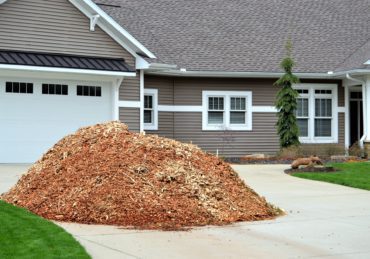Controlling grubs in lawns and gardens is essential for maintaining healthy, thriving landscapes. Grubs, particularly Japanese beetle larvae, feed on grass roots, causing brown patches and weakened turf. One effective, natural solution for grub control is milky spore, a bacterium (paenibacillus popilliae) that specifically targets Japanese beetle larvae. When applied to the soil, the spores infect grubs, multiplying within their bodies and eventually killing them. As the dead grubs decompose, more spores are released into the soil, providing long-term protection by creating a self-sustaining cycle.
Application is simple and easy for homeowners do to themselves and requires only a single application. Milky spore powder is spread evenly over the lawn and watered in to help it penetrate the soil. However, timing is crucial for effectiveness; applications should be made when grubs are actively feeding, typically in late summer to early fall. With patience, this natural method can significantly reduce grub populations over time, leading to a healthier lawn and garden without synthetic chemicals.
What Is Milky Spore and How Does It Work?
Milky spore is a biological grub control method that contains spores of the bacteria Paenibacillus popilliae, specifically targeting Japanese beetle larvae. When applied to the soil, the microscopic spores remain dormant until they are consumed by feeding grubs. Once inside the grub’s digestive system, the spores multiply rapidly, causing a fetal infection. As the infected grubs die and decompose, millions of new spores are released back into the soil, continuing the natural cycle of infection. This process allows milky spore disease to spread gradually, creating a self-sustaining grub control solution that does not require repeated chemical treatments.
Although milky spore does not produce immediate results, its effectiveness increases over time as more spores accumulate in the soil. It typically takes two to three years for the spore population to reach levels that significantly reduce grub numbers. However, once established, milky spore can provide prolonged white grub control can last 10 to 20 years. This long-term approach makes it an excellent option for homeowners seeking a natural, environmentally friendly alternative to synthetic pesticides. Since milky spore specifically targets Japanese beetle larvae, it does not harm beneficial insects, earthworms, pets, or humans. To achieve the best results, proper application timing is essential, typically in late summer to early fall when grubs are actively feeding. By using milky spore, gardeners and homeowners can effectively manage grub populations, leading to healthier lawns and gardens while minimizing chemical use in the environment.
Easily hire the best lawn & landscape pros working in your neighborhood.
When to Apply Milky Spore for Best Results
Timing the application of milky spore correctly is crucial for ensuring maximum effectiveness in controlling Japanese beetle grubs. The best time to apply milky spore is late summer to early fall, when grubs are actively feeding on grassroots and are most vulnerable to infection. During this period, grubs ingest the spores more readily, allowing the bacteria to multiply inside their bodies and spread naturally through the soil. While milky spore can be applied in spring, the results may not be as effective because grubs are nearing the pupation stage and feed less aggressively.
The best time to apply milky spore is in late summer to early fallwhen soil temperatures are above 65°F (18°C), as this supports bacterial activity and grub feeding. Applying milky spore when conditions are too cold can delay its establishment, prolonging the time it takes to build up in the soil. Since the bacteria spread gradually, it is also beneficial to coordinate applications with neighbors. When multiple properties in a neighborhood treat their lawns simultaneously, the spores establish more widely and effectively, leading to faster and more comprehensive grub control. This collective effort can significantly reduce Japanese beetle populations over a larger area, enhancing the long-term benefits of milky spore. By applying at the right time and working together with neighbors, homeowners can maximize the effectiveness of this natural grub control solution, leading to healthier lawns and gardens to years to come.
How to Apply Milky Spore for Grub Control
Tools and Materials Needed
Applying milky spore requires a few essential tools and materials to ensure even distribution and effectiveness. The primary material necessary is milky spore powder or granules, which contain the Paenibacillus popilliae bacteria needed to infect Japanese beetle grubs. For application, a drop type spreader is recommended when using milky spore granules, ensuring even coverage across the lawn. If using the powder form, a shaker tool is more effective. After spreading, a watering can or garden hose is necessary to help the spores settle into the soil, activating them for grub ingestion. While milky spore is non-toxic to humans a pets, wearing protective gloves can help prevent direct skin contact, especially for those with sensitivities. By using the right tools and applying milky spore correctly, homeowners can ensure the milky spore is as effective as possible.
Step-by-Step Application Process
Step 1: Prepare the Lawn or Garden
Before applying milky spore, ensure the soil is moist but not waterlogged. Lightly watering the area a day before application can help create optimal conditions. Avoid applying milky spore in extremely dry conditions, as dry soil can prevent spores from settling properly. Proper lawn and garden care is also essential to preparing for application. It’s important to ensure your lawn is taken care of and clean before applying milky spore.
Step 2: Distribute the Milky Spore Evenly
For powder formulation, use a shaker tool to spread the milky spore while spacing spots about 3 to 4 feet apart. For granules, use a drop spreader and making parallel passes to ensure even distribution across the lawn.
Step 3: Water the Milky Spore Into the Soil
After applying, lightly soak the treated area with a watering can or garden hose. This helps spores settle into the soil, making them accessible to feeding grubs. Avoid excessive watering, which can cause runoff and reduce effectiveness.
Step 4: Repeat Applications If Needed
A single application of milky spore can last 10 to 20 years, but results take time to build. For faster control, applying the product three times per year (spring, summer, and fall) across 2 years can help establish a strong spore presence more quickly.
Easily hire the best lawn & landscape pros working in your neighborhood.
Benefits of Using Milky Spore for Grub Control
Using milky spore for grub control offers several key benefits, making it an excellent choice for homeowners seeking a natural, long-term solution. One of its biggest advantages is its long-lasting effectiveness; a single application can remain active in the soil for 10 to 20 years, continually infecting and reducing Japanese beetle grub populations. Unlike chemical treatments that require frequent reapplication, milky spore establishes itself over time, providing sustained protection with minimal effort.
Milky spore is also organic and completely safe for humans, pets, and beneficial insects such as bees, butterflies, and earthworms. Since it only targets Japanese beetle larvae, it poses no threat to the delicate balance of a garden’s ecosystem. This makes it an environmentally friendly option, helping homeowners reduce reliance on chemical pesticides that can harm non-target organisms and contribute to soil and water pollution.
Another major benefit is that milky spore controls Japanese beetle grubs before they mature into destructive adult beetles. By reducing grub populations, it helps prevent damage to lawns, gardens, and plants, while also minimizing future infestations of beetles and grubs in your lawn, which feed on a variety of ornamental shrubs and edible plants.
Overall, milky spore is an effective, sustainable, and eco-friendly solution that will achieve guaranteed control. Though it requires patience, the long-term benefits far outweigh the initial waiting period, making it a valuable investment for maintaining a healthy, thriving lawn and garden.
How to Tell If Your Lawn Has a Grub Problem
Signs of Grub Infestation
Recognizing the signs of a grub infestation early can help prevent severe lawn damage. One of the most common indicators is the appearance of irregular patches of dead or brown grass that do not recover with watering. Infested turf often becomes loose and lifts easily from the soil, as grubs feed on the grassroots, weakening the lawn’s foundation. Another sign is an increased presence of wildlife, such as birds, skunks, or moles, which dig into the lawn searching for grubs as a food source. Additionally, if you notice large numbers of Japanese beetles in your yard during summer, it could signal a potential grub problem. These adult beetles lay eggs in the soil, which hatch into grubs that feed on the lawn in late summer and fall. Monitoring these signs can help homeowners take timely action to effectively control the grub population and protect their lawn.
Conducting a Grub Test
Conducting a grub test is a simple way to determine if treatment is necessary. To check for grubs, select a random area of your lawn showing signs of damage, such as brown patches or loose turf. Using a shovel or spade dig up a 1-square-foot section of grass and soil, about 2 to 4 inches deep. Gently pull back the turf and examine the soil for white, C-shaped grubs. Count the number of grubs present; if you find more than 10 grubs per square foot, treatment is recommended, as this level of infestation can cause significant damage. If the number is lower, your lawn may recover naturally, but continued monitoring is advised. After inspecting, replace the turf and water the area to help it reestablish.
When Not to Use Milky Spore
While milky spore is an excellent natural grub control method, it is not suitable for all situations. Homeowners in cold climates with short summers may find it ineffective because the bacterium requires warm soil temperatures (above 65°F/18°C) and time to multiple. In regions with brief warm seasons, the spores may not establish well, delaying or preventing long-term control.
Additionally, milky spore only targets Japanese beetle grubs and is ineffective against other grub species, such as those from June beetles or European chafers. If you lawn has a mixed grub population, relying solely on milky spore may not resolve the issue.
Unlike chemical grub killers, which provide fast but temporary results, milky spore takes two to three years to build up in the soil. Homeowners needing immediate grub control may need to supplement with other methods.
Finally, milky spore is not a standalone solution for pest management. To enhance effectiveness, it can be combined with beneficial nematodes, which attack multiple grub species. This integrated approach provides broader, more sustainable pest control, ensuring a healthier lawn over time. Understanding these limitations helps homeowners choose the best strategy for grub control in their specific environment.
FAQs About Milky Spore for Grub Control
How long does it take for Milky Spore to work?
Milky spore is a gradual, long-term grub control solution that requires patience. Unlike chemical treatments that work immediately, milky spore takes two to three years to establish fully in the soil. As Japanese beetle grubs ingest the spores and die, more spores are released, creating a self-sustaining cycle. While some reduction in grub populations may be noticeable within the first year, peak effectiveness occurs after several seasons, providing decades of natural protection once established.
How often should Milky Spore be applied?
Milky spore typically requires only one application for long-term grub control, as it remains in the soil for 10 to 20 years. However, for faster results, it can be applied three times per year (spring, summer, and fall) for two consecutive years to help establish the spores more quickly.
Can Milky Spore be used in vegetable gardens?
Yes, milky spore can be safely used in vegetable gardens. It is a natural, non-toxic bacterium that targets only Japanese beetle grubs and does not harm plants, humans, pets or beneficial insects. Simply apply it to the soil as directed, ensuring proper watering to help the spores establish, and enjoy long-term grub control without chemical pesticides.
Will Milky Spore harm beneficial insects?
No, milky spore will not harm beneficial insects. It specifically targets Japanese beetle grubs and does not affect bees, butterflies, earthworms, or other helpful organisms. Because it is a natural bacterium, it works selectively, making it a safe and eco-friendly option for grub control without disrupting the garden’s ecosystem.
Final Thoughts on Milky Spore for Grub Control
Milky spore is a natural, organic solution for controlling Japanese beetle grubs, offering long-term protection with minimal environmental impact. Unlike chemical treatments that provide quick but temporary results, milky spore establishes a self-sustaining cycle in the soil, infecting and killing grubs while continuously mulitplying.
For best results, milky spore should be applied in late summer or early fall, when grubs are actively feeding. This ensures they ingest the spores, allowing the bacteria to spread naturally. While a single application can provide 10 to 20 years of protection, homeowners seeking faster results can apply it multiple times over two years to accelerate establishment.
Patience is key, as full effectiveness takes two to three years, but once established, it offers long-lasting grub control without harming beneficial insects, pets, or humans. While it only targets Japanese beetle grubs, it can be combined with beneficial nematodes for broader pest control.
Milky spore is an excellent choice for those looking for a sustainable, eco-friendly grub control method. By applying it at the right time and using proper techniques, homeowners can protect their lawns and garden from grub damage while reducing reliance on synthetic pesticides.





